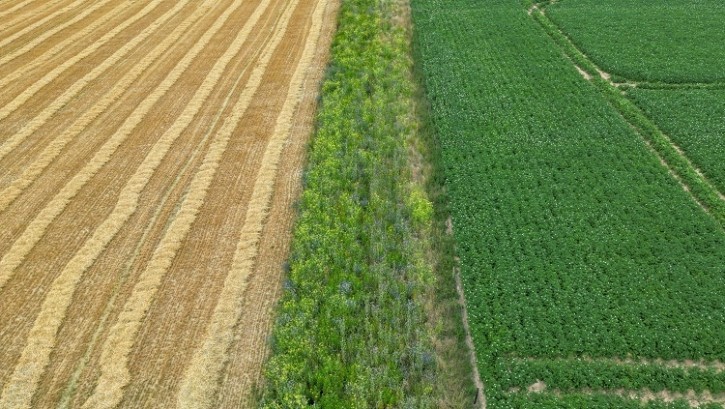‘Many forgotten crops have been neglected by global food systems’: Threats to agrobiodiversity and the benefits of crop diversification

Commodity crops such as wheat, rice, soybeans and corn are eaten the world over, and grown in vast quantities as a result. But there is a universe of crops that human beings could be eating, most of which have neglected.
While there are 7,039 edible plant species, and 417 of these are considered food crops, 90% of human calorie intake is taken up by only 15. This leaves a lot left over with the potential to feed more people.
“Agrobiodiversity measures the species richness in a certain area, just as biodiversity,” University of West London lecturer and PhD researcher at Royal Botanic Gardens Kew Szymon Lara told FoodNavigator, “however it deals with the agrifood sector, mainly through the evaluation of species richness in the agricultural scope. Agrobiodiversity is interlinked with other concepts such as dietary diversity, food security and nutrition security.”
With the many dangers of only using a small number of crops – poor nutrition, poor food security, environmental degradation – the discovery of other edible crops, and the exploration of whether they can be made commercially available, may be able to mitigate some of these difficulties, Szymon told us. His research suggests that this is, indeed, possible.
The origins of the problem
Since the Second World War, the global food system has steadily been relying on fewer and fewer crops, in a process known as ‘McDonaldisation.’
“Population growth required a stable supply of calories and nutrients,” Szymon told us. “The agricultural sector, together with broadly understood climatic changes, urban developments, introduction of invasive species, transport infrastructure and other causes, have taken up the biodiverse land, and in many places, changed it into monocrop deserts.”
The change has been driven by two key factors: technological innovation, which often relies on crop uniformity, and market pressures, with consumers clamouring for consistent size, shape, and quality.

“The standardisation of food productions systems, mainly in the Global North, started to emerge after the Second World War because of imminent hunger and starvation. Technological progress in agriculture and food processing machineries has further stimulated the change, as many of these technologies relied on crop uniformity.
“This inadequately changed people’s perception towards food, and the farm-to-fork connections started to crumble, with many not knowing where their food comes from nowadays.
“These have evolved into modern standards of uniformity that are key, not just for the agrifood sector stakeholders, but also to the consumer, who demands the same quality every time the person goes shopping or is dining out. The general consumer expects their food, including the fruits and vegetables, to be uniform in shape, colour, size, flavour and price, and the commodified crop systems deliver on that promise, at the cost of agrobiodiversity and food wastage.”
The dangers of crop standardisation
With the overreliance on such a small number of crops, human beings are vulnerable to threats to these crops, which makes the global food system more precarious. Namely, a poorly diversified food system is vulnerable to threats to its few crops.
“We rely on these crops,” Szymon told us, “and without them, we could not be able to function as a civilisation. This has been observed recently, in the Russia-Ukraine war, where the destabilised crop systems put millions of people at the risk of hunger or starvation, or in sub-Saharan Africa. At the same time, European markets have been flooded with poor quality crop, having significant economic implications”
Crops can be disrupted easily given the right circumstances, posing a genuine danger to large sections of the food system. For example, diseases can wipe out a single crop, as happened in the 1950s when Panama disease wiped out the global market of ‘Gros Michel’ bananas. The most popular variety today, the ‘Cavendish’ variety, is currently threatened by the same disease, but it’s one of the few commercial banana varieties with the desired characteristics currently available.
Beyond the insecurity that low agrobiodiversity provides us with, it also creates nutritional problems, restricting the nutrients consumers can get. “These commodity crops are often associated to nutritional insecurity, loss of dietary diversity and, when put together with other issues such as loss of cooking skills and the decline in general household economics, are further linked to chronic conditions such as diabetes and obesity.
“This is because these crops provide the resources for the highly and ultra processed products, which are often high in sugar, salt and fat.”
Finally, they can be destructive to the health of the natural world: the lack of agrobiodiversity is bad for soil health.
“From a global perspective, agrobiodiversity is a key component of food and nutrition security, and its maintenance across the agricultural scope, through for example the application of less intensive agricultural practices, intercropping and propagation of forgotten crops, which could help to build more resilient and sustainable food supply chains,” Szymon told us.
On the other hand, “reduction in agrobiodiversity stimulates soil erosion, groundwater acidification, soil nutrient depletion and continues to neglect underutilised crops, heritage varieties and landraces. Growth or even the maintenance of current trends in agrobiodiversity, especially in the developed countries, leads to environmental degradation.
“Furthermore, since many of modern commodity crops have been genetically altered, either naturally or artificially, to meet certain standards, some factors, such as abiotic and biotic stresses, including pests, weeds, disease, and weather fluctuations, make the food supply more fragile to other unpredicted factors. In the time of drastic climatic changes, the standardised commodity crops might not be equipped with the required defensive mechanism to sustain the changes and provide sufficient supply of food for the people.”
The benefits of diversifying and the route to the use of ‘forgotten’ crops
The big question is, then, could ‘forgotten’ crops help mitigate these problems, reducing risk, improving nutrition and even increasing soil health?
There is certainly potential in diversification from a nutritional perspective, according to Szymon. “Partial diversification of the food systems with new crops, such as forgotten crops, heritage varietals or landraces could be a good strategy to elevate calorie and nutrient availability, especially in areas effected by nutrition insecurity,” he told us.
“For example, the once widely present cactuses across Mexican cuisines, such as Carnegiea tetetzo L., Cereus chiotilla L. or the introduced legume - pigeon pea as an alternative protein and fibre source, used to be household staples, providing essential minerals and vitamins, dietary fibre, and water, especially important for peoples living in water insecure areas.”
There are barriers around consumer acceptability, but Szymon, whose PhD research found that three ‘forgotten’ varieties of pea had higher scores on sensory profile metrics than widely used ones, believes that this problem can be overcome.
“The general consumer likes the uniformity of the product,” he told us. “New crops have not been intensified to the extent other commodity crops have and therefore could be deemed as unprofitable to the stakeholders. However, many forgotten crops that have been neglected by the global food systems could possess some significant characteristics that could be economically feasible.”
For example, “some of the evaluated landraces and heritage varieties of commodity fruits and vegetable, such as watermelons, peas, carrots, apples and pears, are claimed to have better flavour and texture over their commercial relatives.
“This is perfectly illustrated by the professional chefs, who often prefer to purchase and cook with local ingredients, grown by a known-to-them farmer or in the kitchen back garden, often exchanging the heritage seeds between themselves. Moreover, food grown in such a way has a story that can be told the customer or consumer and could elevate marketability of the product.”

There are varieties all over the world that can be appealing to consumers, as some success stories show. “Crops that have been neglected by the wider agriculture, but are still cultivated on a small scale, such as the African Fonio, have proved to be of great economic potential.
“Fonio is a grain, that has been popularised by a chef entrepreneur, Pierre Thiam, and thanks to its sourcing from smallholder-indigenous farmers and giving the local communities prosperity and investments opportunities, has successfully appealed to many North American consumers and is now widely available in many American and European stores.”
Szymon believes that the African Fonio could take the same journey with consumers as quinoa, which was once underutilised and is now a favourite globally. Other suggestions he gave for potentially successful but currently underutilised crops are the Small-Bone-Apple from South Africa, Cabbage tree from Mali or Enset from the Ethiopian Highlands. Closer to home, Western consumers have heritage and orphan varieties (under-consumed yet important crops that are not globally traded), such as the heirloom tomato.
“Elevating future food and nutrition security does not only have to rely on building resilience and sustainability in production systems,” Szymon concluded, “but also popularisation of underutilised crops that are widely available.”
















